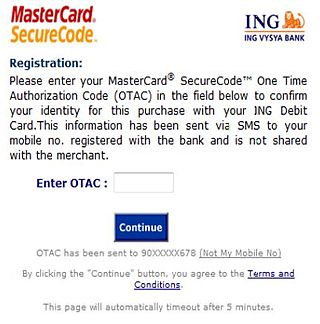Kerberos is a computer-network authentication protocol that works on the basis of tickets to allow nodes communicating over a non-secure network to prove their identity to one another in a secure manner. Its designers aimed it primarily at a client–server model, and it provides mutual authentication—both the user and the server verify each other's identity. Kerberos protocol messages are protected against eavesdropping and replay attacks.
In computing, the Challenge-Handshake Authentication Protocol (CHAP) is an authentication protocol originally used by Point-to-Point Protocol (PPP) to validate users. CHAP is also carried in other authentication protocols such as RADIUS and Diameter.
In cryptography and computer security, a man-in-the-middle (MITM) attack is a cyberattack where the attacker secretly relays and possibly alters the communications between two parties who believe that they are directly communicating with each other, as the attacker has inserted themselves between the two parties.
Transport Layer Security (TLS) is a cryptographic protocol designed to provide communications security over a computer network. The protocol is widely used in applications such as email, instant messaging, and voice over IP, but its use in securing HTTPS remains the most publicly visible.
Remote Authentication Dial-In User Service (RADIUS) is a networking protocol that provides centralized authentication, authorization, and accounting (AAA) management for users who connect and use a network service. RADIUS was developed by Livingston Enterprises in 1991 as an access server authentication and accounting protocol. It was later brought into IEEE 802 and IETF standards.
In computer security, challenge–response authentication is a family of protocols in which one party presents a question ("challenge") and another party must provide a valid answer ("response") to be authenticated.

The Needham–Schroeder protocol is one of the two key transport protocols intended for use over an insecure network, both proposed by Roger Needham and Michael Schroeder. These are:
The Wide-Mouth Frog protocol is a computer network authentication protocol designed for use on insecure networks. It allows individuals communicating over a network to prove their identity to each other while also preventing eavesdropping or replay attacks, and provides for detection of modification and the prevention of unauthorized reading. This can be proven using Degano.
An authentication protocol is a type of computer communications protocol or cryptographic protocol specifically designed for transfer of authentication data between two entities. It allows the receiving entity to authenticate the connecting entity as well as authenticate itself to the connecting entity by declaring the type of information needed for authentication as well as syntax. It is the most important layer of protection needed for secure communication within computer networks.
LAN Manager is a discontinued network operating system (NOS) available from multiple vendors and developed by Microsoft in cooperation with 3Com Corporation. It was designed to succeed 3Com's 3+Share network server software which ran atop a heavily modified version of MS-DOS.

A one-time password (OTP), also known as a one-time PIN, one-time authorization code (OTAC) or dynamic password, is a password that is valid for only one login session or transaction, on a computer system or other digital device. OTPs avoid several shortcomings that are associated with traditional (static) password-based authentication; a number of implementations also incorporate two-factor authentication by ensuring that the one-time password requires access to something a person has as well as something a person knows.
The Secure Remote Password protocol (SRP) is an augmented password-authenticated key exchange (PAKE) protocol, specifically designed to work around existing patents.

Digest access authentication is one of the agreed-upon methods a web server can use to negotiate credentials, such as username or password, with a user's web browser. This can be used to confirm the identity of a user before sending sensitive information, such as online banking transaction history. It applies a hash function to the username and password before sending them over the network. In contrast, basic access authentication uses the easily reversible Base64 encoding instead of hashing, making it non-secure unless used in conjunction with TLS.
Extensible Authentication Protocol (EAP) is an authentication framework frequently used in network and internet connections. It is defined in RFC 3748, which made RFC 2284 obsolete, and is updated by RFC 5247. EAP is an authentication framework for providing the transport and usage of material and parameters generated by EAP methods. There are many methods defined by RFCs, and a number of vendor-specific methods and new proposals exist. EAP is not a wire protocol; instead it only defines the information from the interface and the formats. Each protocol that uses EAP defines a way to encapsulate by the user EAP messages within that protocol's messages.
In cryptography, the interlock protocol, as described by Ron Rivest and Adi Shamir, is a protocol designed to frustrate eavesdropper attack against two parties that use an anonymous key exchange protocol to secure their conversation. A further paper proposed using it as an authentication protocol, which was subsequently broken.
Mutual authentication or two-way authentication refers to two parties authenticating each other at the same time in an authentication protocol. It is a default mode of authentication in some protocols and optional in others (TLS).
In cryptography, CRAM-MD5 is a challenge–response authentication mechanism (CRAM) based on the HMAC-MD5 algorithm. As one of the mechanisms supported by the Simple Authentication and Security Layer (SASL), it is often used in email software as part of SMTP Authentication and for the authentication of POP and IMAP users, as well as in applications implementing LDAP, XMPP, BEEP, and other protocols.
In a Windows network, NT LAN Manager (NTLM) is a suite of Microsoft security protocols intended to provide authentication, integrity, and confidentiality to users. NTLM is the successor to the authentication protocol in Microsoft LAN Manager (LANMAN), an older Microsoft product. The NTLM protocol suite is implemented in a Security Support Provider, which combines the LAN Manager authentication protocol, NTLMv1, NTLMv2 and NTLM2 Session protocols in a single package. Whether these protocols are used or can be used on a system which is governed by Group Policy settings, for which different versions of Windows have different default settings.
In computer security, pass the hash is a hacking technique that allows an attacker to authenticate to a remote server or service by using the underlying NTLM or LanMan hash of a user's password, instead of requiring the associated plaintext password as is normally the case. It replaces the need for stealing the plaintext password to gain access with stealing the hash.
In cryptography, the Salted Challenge Response Authentication Mechanism (SCRAM) is a family of modern, password-based challenge–response authentication mechanisms providing authentication of a user to a server. As it is specified for Simple Authentication and Security Layer (SASL), it can be used for password-based logins to services like SMTP and IMAP (e-mail), XMPP (chat), or MongoDB and PostgreSQL (databases). For XMPP, supporting it is mandatory.



